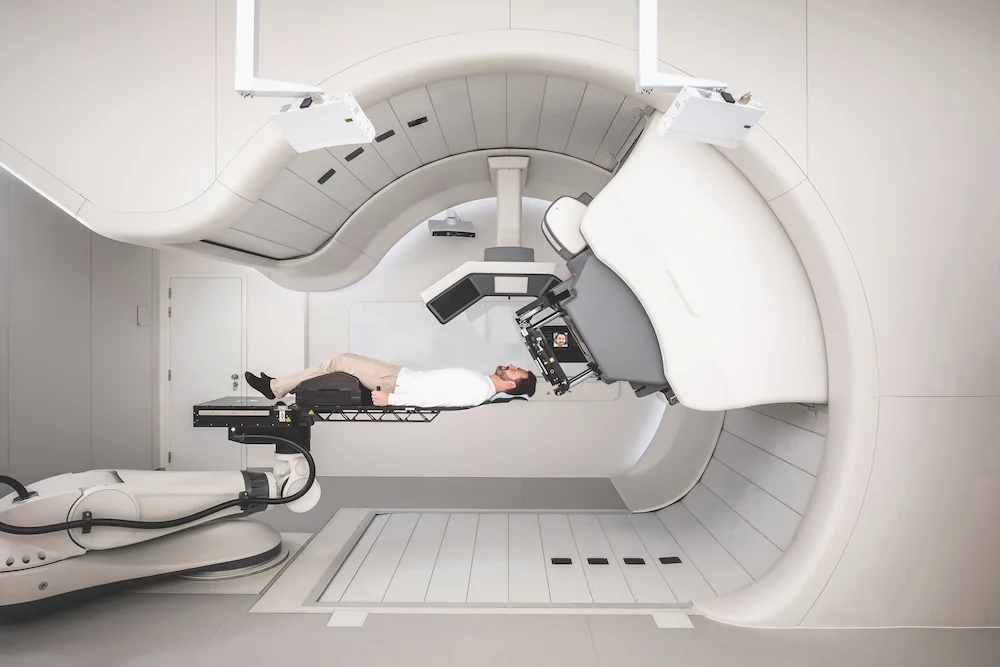News & Articles

Proton Therapy: A Breakthrough in Cancer Care

Proton therapy, a type of radiation therapy that uses protons to kill cancer cells, is one of the latest developments in the field of radiation oncology in Singapore. Dr Edward Yang, Dr Ivan Tham, Dr Lee Kuo Ann, Dr Lee Kim Shang and Dr Anselm Lee explain its impact on cancer care at the Advanced Modalities in Cancer Treatment seminar.
Cancer is one of the most prevalent diseases worldwide, with an estimated 2.2 million cases and 1.4 million deaths annually in Southeast Asia alone1.
Over the decades, major advances in medical technology and research have led to new breakthroughs in cancer treatment. One of them is proton therapy: a type of radiation therapy that uses protons to kill cancer cells. The treatment, along with Gamma Knife and TrueBeam linear accelerators, are hitting the shores in Singapore with the opening of the new proton therapy centre at Mount Elizabeth Novena Hospital.
What is proton therapy?
Proton therapy is a highly advanced and precise radiation treatment that uses proton beams to destroy cancer cells, shared Dr Edward Yang, Senior Consultant, Radiation Oncology.
“A proton is a subatomic particle found in the nucleus of every atom. The particle has a positive electric charge, equal and opposite to the electron,” he explained. “Proton therapy is essentially a type of particle therapy that uses a beam of protons that can be modulated to irradiate diseased tissue, most often to treat cancer.”
Compared to traditional radiation treatment which uses X-ray beams, the main difference with proton therapy is that when the proton beam is shot into the body targeting the area of cancer, it delivers minimal entrance radiation and stops without moving beyond the tumour. In other words, there is no exit dose, and surrounding healthy organs and tissues are spared from radiation exposure.
Improved treatment precision for patients
Protons decelerate faster than photons used in traditional radiation treatment. They also deposit more energy as they slow down, culminating in a peak, known as Bragg Peak.
Because of its molecular properties, proton therapy can deliver an extremely high dose of radiation to a very localised site, which brings with it an abundance of benefits:
- Minimal radiation to healthy tissue
- Reduced risk of secondary cancers
- Safe dose escalation associated with higher overall survival
- Reduced risk of radiation-induced malignancy in young patients
- Significantly lower risk of adverse side effects and toxicity
In the case of brain tumours, the increased precision offered by proton therapy can reduce IQ loss and, in paediatric patients, growth disturbances. It also has particular applications to liver cancer as liver function is usually easily affected depending on the dose of conventional therapy.
In general, proton therapy has the potential to deliver better outcomes and longer survival for patients.
Effectiveness in cancer management
Proton therapy is beneficial in a wide range of cancers, including cancers of the brain, oesophageal, gastrointestinal, head and neck, liver, lymphoma, prostate, soft tissue, and spine.
Proton therapy can also benefit both adult and paediatric patients.
However, Dr Yang highlighted that not everyone can benefit from proton therapy; patients must be carefully selected, and treatment is subject to review and approval from a multidisciplinary tumour board. The cost of treatment is also high due to the high costs of facility setup and maintenance.
Dr Ivan Tham, Senior Consultant, Radiation Oncology explained that proton therapy can be less robust and more complex than traditional radiation treatment.
“Bragg Peak is sensitive, and so, any changes in the patient’s body can potentially affect treatment accuracy”, he said. “This makes all the difference between cure and toxicity.
“Hence, our system will have multiple layers of checks and quality assurance processes to ensure that our patients are treated as effectively and as safely as possible.”
Dr Lee Kuo Ann Senior Consultant, Radiation Oncology added that more care is required when performing proton therapy to ensure that the beam does not overshoot or undershoot the target. He also highlighted that as we only have retrospective data at the moment, more randomised trials are needed to convince doctors and patients on the benefits of proton therapy.
Proton therapy in paediatric patients
One area that Dr Lee Kim Shang, Senior Consultant, Radiation Oncology and Dr Anselm Lee, Senior Consultant, Paediatric Medicine, Paediatric Haematology and Oncology, emphasised on was the impact of proton therapy on paediatric patients.
In general, special attention must be paid when treating children with radiation as the structures of their bodies are smaller, and are thus more likely to experience higher radiation exposure to healthy organs and tissue.
In addition, the impact of long-term side effects of treatment is greater for children as they have many years of survival ahead of them. This includes concerns about reduced fertility, abnormal growth or development, second cancer, and endocrine dysfunction.
Dr Lee Kim Shang pointed out that proton therapy is able to address many of these issues as proton beams can enter the body at a much lower entrance dose than traditional radiation treatment. There is also little or no dose in the normal tissue beyond the tumour, leading to much less radiation exposure and lower or less severe long-term side effects.
With the opening of the new proton therapy centre and the estimated availability of proton clinical services in early 2023, we can offer proton therapy as an advanced radiation treatment option to benefit patients both young and old, complemented by multidisciplinary care in medical and surgical oncologies.
1 World Health Organisation Southeast Asia, https://www.who.int/southeastasia/news/detail/04-02-2022-urgently-address-gaps-in-cancer-care-who
| POSTED IN | Cancer Treatments |
| TAGS | cancer latest breakthrough, common side effects of cancer treatment, new ways to treat cancer, radiofrequency (RF) radiation, radiotherapy (radiation therapy), tumours |
| READ MORE ABOUT | Head and Neck Cancer |
| PUBLISHED | 01 December 2022 |
